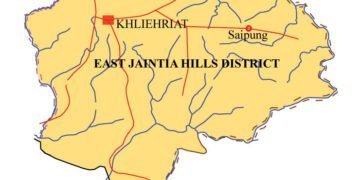An AI-Integrated marine robotic boat was for the first time sent into the Umiam lake to collect the accumulated floating waste.
Spearheaded by the State government under its Smart Village Movement (SVM) initiative in collaboration with technology partner Clearbot, the robotic boat was demonstrated at Kyndong Rella in Mawdun area of the lake.
Clearbot creators, Sidhant Gupta and Utkarsh Goel were in the lake to give their final demonstration today on how the cutting-edge technology that can revolutionise waste collection.
The creators told Highland Post that the robot boat can do the cleaning and monitoring without needing extensive manpower as it can be remotely controlled or operated autonomously where it scoops up floating debris and feeds it to an onboard conveyor belt and onto a holding bin at the stern with a collection capacity of 200 kg.
It is hoped that the AI-powered marine boats will offer an effective solution to combat water pollution by identifying and targeting pollution hotspots, providing real-time monitoring and adaptable strategies.
“This is the first time that we came here and I was visibly shaken by the amount of waste but our machine is built for this,” Utkarsh said.
Sidhant said the boats were also used in Hong Kong, Banaras and Kerala. “This is our first time in the North East and we hope that the government and the public will support us in this mission to clean up the Umiam Lake.”
Siddhant said the partnership with Meghalaya exemplifies their commitment to innovative solutions for environmental rejuvenation. “Through this pilot, we aim to demonstrate how technology-driven clean-up initiatives can contribute to holistic rural development, aligning with the movement’s vision for a sustainable future,” he added.
Meanwhile, Nodal Officer of SVM Ramkumar S said, “We were excited to see this pilot taking shape and witness a milestone in waste management. This initiative aligns with our commitment to foster a cleaner and more sustainable environment through technology-driven solutions.”
Tulenam Laloo, Fellow at UC Berkeley and Director of Operations for the SVM in Meghalaya said the technology was first tested in Bali, Indonesia for tourism use cases and we are using them in Meghalaya today to solve waste collection in a famous touristic site as well.
“Such models will create standard processes to handle waste in a timely manner making operations more efficient than conventional ones. These technologies must be leveraged to a great extent to address the growing menace of waste and help scale such models them to similar locations,’’ Tulenam said.
A local fisherman remarked that a lot of catchment areas of waste in water bodies are sites that can be difficult to reach and most of the time there is no regular way for authorities to manage it. On top of that- issues like rainfall, absence of waste collection accumulates in such areas.
The technology presents an economical method for effectively removing debris, oil, and, all while operating on electric power. With the capacity to gather as much as 15 litres of oil and 200 kilograms of floating refuse daily, these models need to be explored in our state, says Pynshai Marpna, Project Lead for the demonstration.
After the demonstration, it is said to collect a total of 250 kgs in less than three hours of swim time. This amalgamation of artificial intelligence and marine engineering exemplified the convergence of innovation and sustainability.
Multiple stakeholders like the Meghalaya Energy Corporation Limited, the Meghalaya Tourism Development Corporation, the tourism department, local municipal authority, the village headman, fishermen and local community members of the Mawdun village were also present to witness this unique initiative.
























